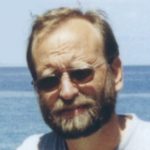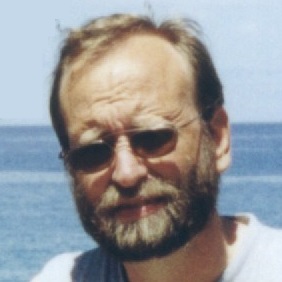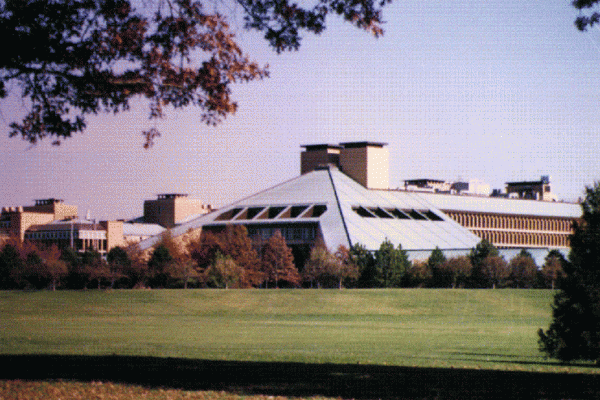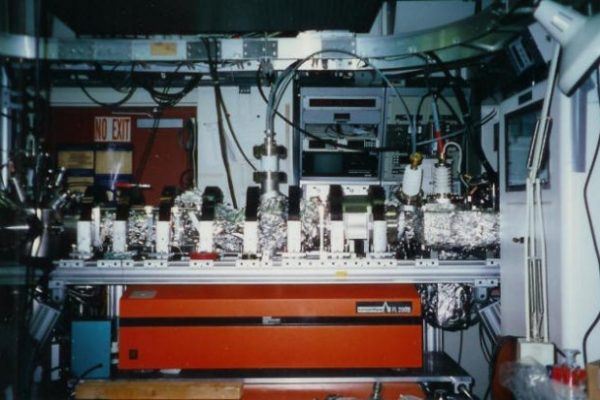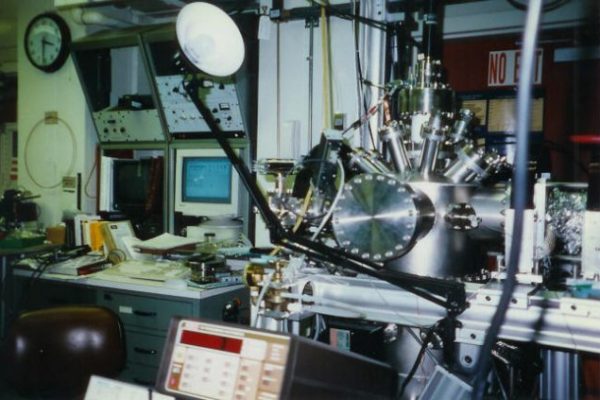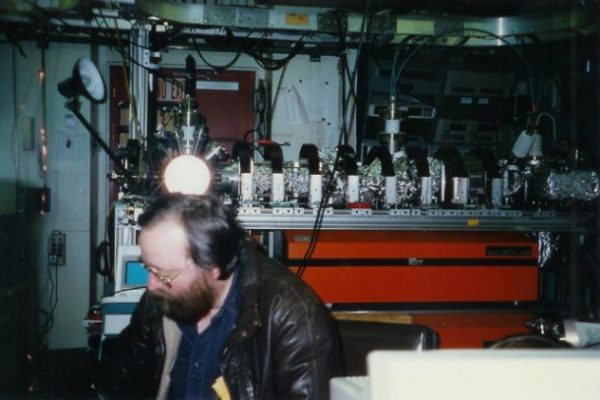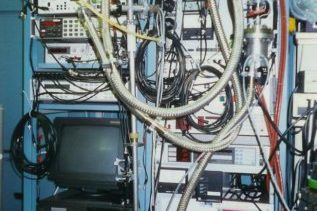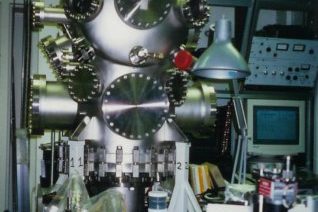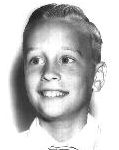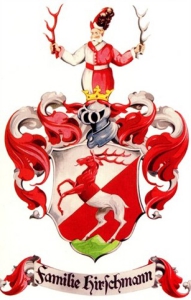Ph.D. (Physics)
Thesis: The Interactions of Muonium with Silica Surfaces
June 1980, Western Washington University, Bellingham, WA, USA
M.Sc. (Physics)
June 1978, Pacific Lutheran University, Tacoma, WA, USA
B.Sc. (Physics)
Visiting Professor of Physics
Research – Principal Investigator
Aug 2014 – Present, Univ. of Notre Dame, Notre Dame, IN, USA
Consultant
Research – Principal Investigator
Aug 1999 – Jul 2014, Dept. of Physics, Univ. of Notre Dame, Notre Dame, IN, USA
Visiting (Aug 1999 – Jul 2004) / Adjunct (Aug 2004 – Jul 2014) Professor of Physics
Research – Principal Investigator
Sep 1999 – Aug 2011, Dept. of Physics, Arizona State Univ., Tempe, AZ, USA
Visiting (Sep 1999 – Aug 2002) / Adjunct (Sep 2002 – Aug 2011) Professor of Physics
Research – Principal Investigator
Feb 1997 – Present, Physikon Research Corporation, Lynden, WA, USA
Vice President (Feb 1997 – Dec 2017) / President (Jan 2018 – Present)
President and CEO
May 1988 – Feb 1997, AT&T/Lucent Bell Laboratories, Murray Hill, NJ, USA
Member of Technical Staff (MTS)
Research – Principal Investigator more
Mar 1986 – May 1988, AT&T Bell Laboratories, Murray Hill, NJ, USA
Postdoctoral Fellow (Pre-Member of Technical Staff – PMTS)
Research
Jan 1986 – Mar 1986, Dept. of Physics, Univ. of British Columbia, Vancouver, BC, Canada
Postdoctoral Fellow
Research
Aug 1980 – Jan 1986, Dept. of Physics, Univ. of British Columbia, Vancouver, BC, Canada
Doctoral Candidate / Research Associate
Research / Teaching Assistant
Sep 1978 – Jun 1980, Dept. of Physics, Western Washington Univ., Bellingham, WA, USA
Masters Candidate
Research / Teaching Assistant
Selected Research Highlights
- Band-Gap Moderated Slow Positive Muon Beams – Dr. Harshman led the research group that discovered the first practical technique for producing a low-energy (<10 eV) positive muon beam. It was christened with the acronym “μSOL” (muon separator online). The same 1986 paper reported the first observation of (< 10 eV) Mu– (i.e., μ+e–e–) ions in vacuum. In 1987, Harshman and co-workers increased the slow muon production rate by a factor of 100 using solid rare-gas moderators, producing a usable flux of slow muons [Physical Review Letters 56, 2850 (1986)] [Physical Review B 36, 8850 (1987)]. ‡The slow muon production technique developed by Harshman and coworkers was adopted by the Paul Sherrer Institut (PSI) for their slow positive muon beam facility (the μSR Yamazaki Prize for this work was awarded to PSI personnel for placing this technology at the end of a PSI surface muon channel).
- Magnetic X-Ray Scattering in Holmium – By measuring the degree of linear polarization we identify the orbital and spin contributions to the x-ray magnetic scattering in holmium. When the incident x-ray energy is tuned through the Lm absorption edge, we observe a fiftyfold resonant enhancement of the magnetic signal, and resonant integer harmonics. The line shapes of the two linear components scattered parallel and perpendicular to the diffraction plane are distinct in energy with a 6-eV splitting [Physical Review Letters 61, 1241 (1988)] [Physical Review B 43, 5663 (1991)]. ‡This experimental work was cited for the 2003 Arthur H. Compton Award, presented to its first and fourth authors, along with two others not directly involved with these experiments (Dr. Harshman declined first-authorship of the PRL owing to other obligations at the time). In addition to taking part in all aspects of this research, Dr. Harshman also commissioned and supervised the engineering of the novel x-ray spectrometer necessary for its success. During the experiment the acquisition computer failed; Dr. Harshman made the round trip from Cornell to Bell Labs to have it repaired.
- High-Temperature Cuprate Superconductor Pairing State Symmetry – In 1987 using muon spin rotation (μ+SR) and measuring sintered powder samples of YBa2Cu3O7–δ, Harshman and coworkers provided the first measurements of the magnetic penetration and proof that the bulk pairing state of the superconducting hole condensate was nodeless, consistent with s-wave pairing and strong coupling [Physical Review B 36, 2386 (1987)]. Harshman and co-workers were also the first to measure the 60 K (oxygen-ordered) phase of YBa2Cu3O7–δ. This research was followed by studies of heavily twinned single crystals of the same material, confirming the s-wave character and providing the first measurement of the mass anisotropy; mc ≥ 25 mab [Physical Review B 39, 851 (1989)]. In 1991, Harshman and co-workers presented μ+SR data on single-crystal Bi2Sr2CaCu2O8+δ showing a strongly temperature-dependent line shape, indicative of motional narrowing arising from fluxon depinning [Physical Review Letters 67, 3152 (1991)]. The fluxon lattice in earlier powder and heavily-twinned crystal samples of YBa2Cu3O7–δ was strongly pinned, suppressing fluxon depinning. However, by the mid 90’s, the quality of YBa2Cu3O7–δ crystals improved greatly, revealing a text-book example temperature-activated fluxon depinning. Unfortunately, some researchers misinterpreted the extrinsic effects of fluxon depinning as being evidence of d-wave pairing. To correct this misrepresentation, Harshman and co-workers conducted series of μ+SR experiments on a single-crystal of YBa2Cu3O7–δ, measuring the second moment of the frequency distribution, σ(T0,H), as a function of both temperature and applied field. The strong (and non-monotonic) field dependence exhibited by σ(T→0,H),confirmed the presence of temperature-activated fluxon depinning. By applying a self-consistent analysis approach, and accounting for the effects of fluxon depinning, Harshman and co-workers showed that the underlying gap function of the superconducting hole condensate was nodeless, and best described by the two-fluid model [Physical Review B 69, 174505 (2004)] [Physical Review B, 72, 146502 (2005)]. In 2011, Harshman and Fiory extended this analysis technique to YBa2Cu4O8 and La2-xSrxCuO4 [Journal of Physics: Condensed Matter 23, 315702 (2011)]. ‡This line of research has proven that the bulk high-TC pairing symmetry of the hole condensate in the cuprates is nodeless, consistent with s-wave and strong coupling, and has shown how fluxon motion can significantly affect the μ+SR data, even for single-crystal YBa2Cu3O7–δ, and how to account for it.
- Oxygen Isotope Effect in High-TC Materials – For high-TC superconductors in which transition temperatures, TC, are reduced by doping, the oxygen isotope effect (OIE) coefficient in TC is shown to increase systematically with the pair-breaking rate and with the valence difference between the substituted and native ions. Moreover, the OIE in TC tends to zero as one approaches optimum (or ideal) stoichiometry at which the quality of the superconducting condensate is maximized. In materials with isovalentsubstitutions, e.g., Sr for Ba or Zn for Cu in YBa2Cu3O7–δ, the small OIE of the parent (unsubstituted) compound is magnified, owing to pair-breaking disorder. In materials with heterovalent substitutions, e.g., La or Pr for Ba, where carrier densities are necessarily changed, pair-breaking induces a much larger OIE. A seminal case is Pr-doped YBa2Cu3O7–δ, where data were previously misinterpreted, owing to the false assumption that Pr substitutes only for Y. It is now clear, however, that the decrease in TC observed with Pr doping actually arises from pair-breaking caused by Pr-on-Ba-site defects introduced during crystal growth. When PrBa2Cu3O7–δ is grown correctly without such defects, TC remains unchanged (as in the case of most other rare earth substitutions for Y). Invariance of TC under a 60% rare-earth mass increase provides strong evidence against phononic pairing mechanisms. The fact that TC drops when Pr substitutes for Ba, but not for Y, indicates that the superconducting hole condensate resides in the BaO layers, where pair-breaking degrades TC and dramatically increases the OIE. Superconductive pairing modeled on Coulomb coupling between the hole (BaO) and the electron (CuO2) layers is shown to resolve the serious shortcomings inherent in approaches based on electron-phonon interactions and is found to be generally applicable. Moreover, the OIE in the magnetic penetration depth in alloys is shown to be constant, with degradation of TC up to 50%, and thus is unrelated to the OIE in TC [Physical Review B 77, 024523 (2008)] [Physical Review B 80, 136502 (2009)]. ‡This theoretical work corrects several earlier papers on the isotope effect in high-TC compounds, concludes non-phononic mediation and casts the isotope effect into isovalent and heterovalent substitutional categories. Interpretations of differential OIE, combined with specific heat and thermal conductivity data indicate two interacting mobile carrier bands: one of holes and the other, electrons.
- Coexistence of Holes and Electrons in High-TC Compounds – Normal state resistivity and Hall effect are shown to be successfully modeled by a two-band model of holes and electrons that is applied self-consistently to (i) DC transport data reported for eight bulk-crystal and six oriented-film specimens of YBa2Cu3O7–δ, and (ii) far-infrared Hall angle data reported for YBa2Cu3O7–δ and Bi2Sr2CaCu2O8+δ. The electron band exhibits extremely strong scattering; the extrapolated DC residual resistivity of the electronic component is shown to be consistent with the previously observed excess thermal conductivity and excess electrodynamic conductivity at low temperature. Two-band hole-electron analysis of Hall angle data suggest that the electrons possess the greater effective mass [Philosophical Magazine 91, 818 (2011)] [arXiv]. ‡Theoretical analysis of Hall effect data in high-TC compounds showing the presence of two distinct carrier types of opposite sign. By applying a two-band model to the data from several DC and AC transport measurements, Dr. Harshman and co-workers were able to prove that mobile electrons coexist with the holes in the high-TC compounds. The electrons were found to be heavier that the holes, possess 3D mobility (while the hole were generally confined to two dimensions) and exhibit strong scattering. This discovery suggested that the heavier electrons may play a role in mediating the pairing of lighter holes.
- Theory of High-TC Superconductivity: Transition Temperature – It is demonstrated that the transition temperature (TC) of high-TC superconductors is determined by their layered crystal structure, bond lengths, valency properties of the ions, and Coulomb coupling between electronic bands in adjacent, spatially separated layers. Analysis of 31 high-Tc materials (cuprates, ruthenates, rutheno-cuprates, iron pnictides, organics) yields the universal relationship for optimal compounds, kBTC0 = β/ℓζ, where ℓ is related to the mean spacing between interacting charges in the layers, ζ is the distance between interacting electronic layers, β is a universal constant and TC0 is the optimal transition temperature (determined to within an uncertainty of ± 1.4 K by this relationship). Non-optimum compounds, in which sample degradation is evident, e.g. by broadened superconducting transitions and diminished Meissner fractions, typically exhibit reduced TC < TC0. It is shown that TC0 may be obtained from an average of Coulomb interaction forces between the two layers [Journal of Physics: Condensed Matter. 23, 295701 (2011)] [arXiv] [Corrigendum: Journal of Physics: Condensed Matter 23 349501 (2011)]. Also listed in J. Phys.: Condens. Matter Highlights of 2011. ‡Seminal work on a theoretical model for high-TC pairing based on Coulomb interactions between two nearest-neighbor charge layers. The fact that the universal constant β is equal to about twice the reduced electron Compton wavelength, and the equation for TC0 in independent of band mass, suggests a central role for Compton scatting in high-TC superconductivity, where pairing is accomplished via virtual photons.
- Expansion of the High-TC Interlayer/Interfacial Pairing Theory – Subsequent to the publication of the seminal work in 2011 (above), the interlayer Coulomb pairing model is shown to apply to other superconductor families; iron calcogenides [Journal of Physics: Condensed Matter 24, 135701 (2012)], the intercalated group-4-metal nitride halides [Physical Review B 90, 186501 (2014)] [Journal of Superconductivity and Novel Magnetism 28, 2967 (2015)] and (CaxLa1–x)(Ba1.75–xLa0.25+x)Cu3Oy (i.e., CLBLCO) [Physical Review B 86, 144533 (2012)]. For the charged compensated CLBLCO compound, the first accurate calculation of TC for the related non-optimal materials is provided. Two Tl-based cuprates of the form Tl1–x(Ba/Sr/La)2CaO5–δ [Journal of Physics and Chemistry of Solids 85, 106 (2015)] are also added to the growing list of compounds for which TC is accurately calculated; a derivation of σ is introduced for the optimal Tl2Ba2Caη–1CuηO2η+2 (for η = 1, 2, 3) compounds, which exhibit a Tl oxidation state at or near +3, obtaining the fundamental value σ0 = 0.228 previously established for YBa2Cu3O6.92. Also reported is the marked enhancement in σ associated with Tl+1 and analogous inner-layer cations relative to higher-valence cations. For a model proposition of σ = σ0, the fractional Tl+1 content of the mixed-valence compound, TlBa2Ca2Cu3O9±δ, is predicted to be 1/3 at optimization, in agreement with existing data. Gate-charged twisted bilayer graphene (TBG) has also been shown to be in compliance with the interlayer Coulomb pairing model [Journal of Superconductivity and Novel Magnetism 33, 367 (2020)]. ‡This work has unequivocally established the nature of the high-TC pairing mechanism to be Coulombic, requiring interaction between two physically separated charge reservoirs. The theory is the only published predictive model for TC in the high-TC field.
- Application of Coulomb Interlayer/Interfacial Pairing Theory to 3D Compounds – The applicability of the interfacial Coulombic pairing mechanism has been extended to the 3D macromolecular A3C60 superconducting family of compounds [Journal of Physis: Condensed Matter 29, 145602 (2017)] accurately predicts the optimal transition temperatures in A15 and fcc Cs3C60. Based upon the differing disorder between H3S and D3S [Superconductor Science and Technology 30, 045011 (2017)], the H-D isotope effect exponent is accurately determined in cubic H3S, thereby setting significant limits on the electron-phonon coupling strength and opening the door to unconventional superconductivity. Subsequent application of the Coulomb interfacial mediation model to H3S gives TC0 = 198.5 ± 3.0 K is in excellent agreement with transition temperatures determined from resistivity (196 – 200 K onsets, 190 – 197 K midpoints), susceptibility (200 K onset), and critical magnetic fields (203.5 K by extrapolation). Analysis of mid-infrared reflectivity data also confirms the expected correlation between boson energy and ζ–1 [Journal of Physics: Condensed Matter 29, 445702 (2017)]. The theory is shown to also apply to the hydrogen clathrates; for LaH10, excellent agreement (within <2 K) with experiment is achieved for two optimal samples, with theoretical transition temperatures of 249.8(1.3) K and 260.7(2.0) K [Journal of Superconductivity and Novel Magnetism 33, 2945 (2020)]. Most recently, the model has been successfully applied to C-S-H [Journal of Applied Physics 131, 015105 (2022)] [arXiv_v3 (2023)]. ‡These results confirm that Coulombic mediation specifically requires physically separated charge reservoirs and is not determined by structural dimensionality.
- The Effect of Interfacial Superconductivity on Electric Field Shielding – A model is presented for two-dimensional superconductivity at semiconductor-on-metal interfaces mediated by Coulomb interactions between electronically-active interface charges in the semiconductor and screening charges in the metal [Physica C: Superconductivity and its Applications 632, 1354600 (2025); Corrigendum: 632, 1354752 (2025)]. The junction considered is native Cu2O on Cu in which an interfacial double charge layer of areal density n, comprising superconducting holes in Cu2O and mediating electrons in Cu, is induced in proportion to a sub-monolayer of adsorbed 4He atoms. Evidence for superconductivity on copper with prior air exposure is revealed in new analysis of previously published work function data. Based on a theory developed for layered superconductors, the intrinsic transition temperature TC = β n1/2/ζ is determined by n and transverse distance ζ ≃ 2.0 Å between the charge layers; β = 1.933(6) e2ƛC/kB = 1247.4(3.7) K-Å2 is a universal constant involving the reduced Compton wavelength of the electron ƛC. This model is applied to understanding the shielding of copper work-function patch and gravitational compression electric fields reported in the Witteborn-Fairbank gravitational electron free fall experiment. Interfacial superconductivity with n ≃ 1.6 × 1012 cm−2, TC ≃ 7.9 K and Berezinskiĭ-Kosterlitz-Thouless temperature TBKT ≃ 4.4 K accounts for the shielding observed at temperature T ≃ 4.2 K. Helium desorption and concomitant decreases in n and TC replicate the temperature transition in ambient electric fields on falling electrons, as observed by Lockhart et al., and the vanishing of superconductivity above T ≃ 4.8 K. ‡These results confirm the plausibility of superconductivity mediated by interlayer Coulomb mediation to explain the shielding effects observed in previous electron free-fall experiments.
Journal Publications and Archived Letters (chronological order) more
Conference Publications more
Invited Talks more
Abstracts more
Work Included in Magazine Articles, Journal Highlights, Editorials & Online Encyclopedias
- The Cinderella Particle, by Hans Christian von Baeyer, Discover Magazine 14(12), 92-97 (1993).
- IOPscience LabTalk (no longer available online): High-Temperature Superconductivity Theory Accurately Predicts Transition Temperatures (27 July 2011).
- Journal of Physics: Condensed Matter | Included in Highlights of 2011: Theory of High-TC Superconductivity: Transition Temperature, Journal of Physics: Condensed Matter 23, 295701 (2011).
- W&M | ScholarWorks: Effects of Vortex Pinning on the Temperature Dependence of the Magnetic Field Distributions in Superconductors (2012); reprinted from Physics Procedia 30, 245 (2012).
- W&M | ScholarWorks (no longer listed due to copyright restrictions): Compressed H3S: Inter-sublattice Coulomb Coupling in a High-TC Superconductor (2017); reprinted from Journal of Physics: Condensed Matter 29, 445702 (2017).
- Wikipedia: Muon spin spectroscopy; Energy classes of muon beams (low-energy muons).
Other Activities
Government Review Panels
- Served on Department of Energy Peer Review Panel, Arlington, VA, 28-30 July 1992.
- Served on Department of Energy Peer Review Panel, Arlington, VA, 1-3 September 1992.
Patents
Radioactive Ion (Implantation), J. Vincent, T. Ruth, A. Zyuzin, J. D’Auria, D. Ottewell and D. R. Harshman (TRIUMF Patent for arterial stents). Priority date for all applications: 12 Dec. 2001.
World / WIPO
European Union
European Union
European Union
Canada
Mexico
France
Germany
United Kingdom
Japan
Korea
United States
WO 03/053509
EP 1 946 796 A2
EP 1 946 797 A2
1463533
N/A
WO 03/053509
N/A
N/A
N/A
2005-513451
N/A
US 2005/0118098 A1
PCT/US02/39557
07150325.4
07150329.6
02787004.7
CA 2,470,006
PA/a/2004/005655
02787004.7
02787004.7
02787004.7
2003-554265
10-2004-7008719
10/498,368
12 Dec 2002
21 Dec 2007
21 Dec 2007
9 Jul 2004
10 Jun 2004
11 Jun 2004
12 Dec 2002
12 Dec 2002
12 Dec 2002
11 May 2004
5 Jun 2004
14 Jan 2005
These patents were allowed to lapse in 2010.
Layered Ionic Superconductor, D. R. Harshman and A. T. Fiory
United States
United States
US 8,703,651 B2
Renewed
13/543,655
Renewed
6 Jul 2012
21 Oct 2021
Copyrights
Voices (Registration No. PAu 2-167-731, 24 February 1997) more
False Winds of Hope (Registration No. PAu 2-095-422, 14 June 1996) more
Faraday Hollander (Registration No. Registration No. TXu 232 915, 20 March 1986) more
Bell Labs Retired, Summit, New Jersey 07901, USA
fiory@alum.mit.edu
Dr. Peter B. Littlewood, Professor of Physics
James Franck Institute, Univ. of Chicago, Chicago, Illinois 76063 USA
Material Science Division
Argonne National Laboratory, Argonne, Illinois 60439, USA
littlewood@uchicago.edu
Dr. James L. Smith, Chief Scientist & Fellow (Emeritus)
Los Alamos National Laboratory
Materials Technology: Metallurgy – MST-6
Los Alamos, New Mexico 87545, USA
jlsmith@lanl.gov
Other Interests: Robotics, Biking, Poetry, Drums, Fishing, Camping, Off-roading




